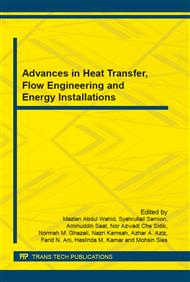p.69
p.74
p.78
p.83
p.88
p.94
p.101
p.107
p.111
Single-Objective Optimization of a Thermoacoustic Refrigerator
Abstract:
Optimization of energy-related systems with by-products that involve environmental degradation has never been so crucial today with depleting resources and global concerns over negative impacts on our environment. This paper reports the results of an optimization scheme on the coefficient of performance (COP) of a standing wave thermoacoustic refrigerator based on genetic algorithm. The environmentally friendly refrigerator operates without any CFCs, which has been associated with the depletion of ozone, a substance that prevents uv light from reaching the earth’s atmosphere. A single-objective optimization to maximize the COP of a thermoacoustic refrigerator has been completed. The variables investigated include the length of the stack, Lsn, center position of the stack, xsn, blockage ratio, B and drive ratio, DR. The results show that a COP of up to 1.64 is achievable which provides promise for future improvements in the present systems.
Info:
Periodical:
Pages:
88-93
Citation:
Online since:
January 2016
Authors:
Price:
Сopyright:
© 2016 Trans Tech Publications Ltd. All Rights Reserved
Share:
Citation:


